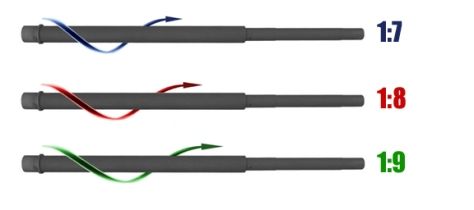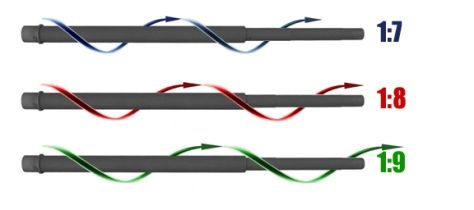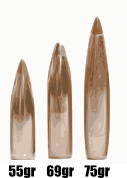Tgace
Grandmaster
twist and shoot the things worth believing in
A little something I wrote last year....
Rifling twist rates can be another head scratcher for the new AR owner. The internet is full of different opinions of what is “best”…often times based on what the writer has purchased and is now trying to justify.
Like any topic of a technical nature, “best” is a relative term. For the beginner, what you need to learn are some simple rules of thumb to help you base a decision on.
Gun makers realized rather quickly that the accuracy of a firearm improved when the projectile had a “pointy end” and was spun. The “point” gives the projectile a streamlined shape that slices through the atmosphere more efficiently and groves machined into the gun barrel impart spin. The spin keeps the bullet stable along its path of flight and prevents it from wobbling or tumbling end over end, both of which would be bad for accuracy. Anyone who has used a gyroscope in HS science class recalls that a spinning object likes to stay in one place and resists change. That’s what you want in a bullet.
The groves in the barrel, as we all know, are called “rifling”.
A rifle barrels rate of spin is expressed as 1: (X) with 1= “One full 360 degree rotation of the bullet” and X= Inches of barrel length.
The most common “Combat AR” twist rates you will find “off the shelf” these days are 1:7, 1:8, and 1:9. Some AR owners like 1:10 and 1:12 barrels and other variants, but in my experience you will find most guys who “run and gun” using one of these three.

If you do the math of dividing barrel length by twist you see that in the common 16″ barrel length a 1:7 twist will spin a bullet twice with 2 inches of the barrel still to go. A 1:8 about twice even, and a 1:9 will spin it once with 7 inches of barrel to go…so “almost twice”. Based on manufacturing variations that’s all approximate but there you go.

So “whats the point?” you are asking?
Well… bullets of any given caliber (AKA: diameter) come in various sizes. Differentiated by weight (measured in “grains”), there is an entire rainbow of .223 caliber bullets ranging from tiny 40 grain bullets up to 80 grain whoppers. Because the diameter of the bullet is fixed, what you get are longer projectiles as the weight increases.
Rules of thumb regarding bullet weight:

Due to a lot of math/physics and stuff I can’t explain, it’s really the length of the projectile and it’s velocity that determine how much spin it will need to fly straight and stable, not the weight. However, we talk about bullets in “grains” so when pairing bullets to rifling twist you just have to consider two facts.
You would think that “more is better” when it comes to twist, but what happens when small/light bullets are overspun is that they fly to pieces once they exit the barrel. Heavier bullets will “overstabilize” if spun too much. That means the point of the bullet wont come down on the decent end of it’s trajectory.
So which should you get? Well what do you want to do and what size bullet do you want to do it with?
The 1:9 is a common twist rate “off the shelf” when you buy an AR. It will work fine with the commonly found 55 grain bullet up to “medium” sized projectiles like 69 grain. Depending on your particular barrel it MAY even stabilize “heavy” bullets…or it may not. Even if it does, variations like temperature and air pressure MAY make it inconsistent with heavy rounds. So out to 300 yards or so 1:9 should be fine. 400-500 yd shots? Probably not so much.
The 1:7 is the current military standard on the M4/M16 and as such is also a commonly found option. It will throw the medium to heavy rounds out past 300 yards. It can also “sufficiently” stabilize 55 grain rounds. You wont get exceedingly small groups with 55gr, and while it MAY stabilize a lighter round for farther shots, you are also at the mercy of your individual barrel and environmental factors.
The 1:8 slides the options to the center. Some praise it as the best of both worlds while others deride it as the “Jack of all trades, master of none” option.
As you can see, in the end all of them can work fine as a general use option. It’s when you want to specialize in a specific range or hunting environment that a specific combination of bullet/twist becomes the optimum choice.
A little something I wrote last year....
Rifling twist rates can be another head scratcher for the new AR owner. The internet is full of different opinions of what is “best”…often times based on what the writer has purchased and is now trying to justify.
Like any topic of a technical nature, “best” is a relative term. For the beginner, what you need to learn are some simple rules of thumb to help you base a decision on.
Gun makers realized rather quickly that the accuracy of a firearm improved when the projectile had a “pointy end” and was spun. The “point” gives the projectile a streamlined shape that slices through the atmosphere more efficiently and groves machined into the gun barrel impart spin. The spin keeps the bullet stable along its path of flight and prevents it from wobbling or tumbling end over end, both of which would be bad for accuracy. Anyone who has used a gyroscope in HS science class recalls that a spinning object likes to stay in one place and resists change. That’s what you want in a bullet.
The groves in the barrel, as we all know, are called “rifling”.
A rifle barrels rate of spin is expressed as 1: (X) with 1= “One full 360 degree rotation of the bullet” and X= Inches of barrel length.
The most common “Combat AR” twist rates you will find “off the shelf” these days are 1:7, 1:8, and 1:9. Some AR owners like 1:10 and 1:12 barrels and other variants, but in my experience you will find most guys who “run and gun” using one of these three.

If you do the math of dividing barrel length by twist you see that in the common 16″ barrel length a 1:7 twist will spin a bullet twice with 2 inches of the barrel still to go. A 1:8 about twice even, and a 1:9 will spin it once with 7 inches of barrel to go…so “almost twice”. Based on manufacturing variations that’s all approximate but there you go.

So “whats the point?” you are asking?
Well… bullets of any given caliber (AKA: diameter) come in various sizes. Differentiated by weight (measured in “grains”), there is an entire rainbow of .223 caliber bullets ranging from tiny 40 grain bullets up to 80 grain whoppers. Because the diameter of the bullet is fixed, what you get are longer projectiles as the weight increases.
Rules of thumb regarding bullet weight:
- Lighter bullets can achieve faster velocities and shoot with a flatter trajectory. Their lack of mass means they wont stay stable at longer ranges and wind has more effect on them at long range.
- Heavier bullets will stay stable over longer distances but have a more “arched” trajectory. Wind has less effect on them at long range.
- The terminal effect of a bullet, or its “striking” power, is due to a combination of it’s mass and velocity.
- Heavier bullets cost more.

Due to a lot of math/physics and stuff I can’t explain, it’s really the length of the projectile and it’s velocity that determine how much spin it will need to fly straight and stable, not the weight. However, we talk about bullets in “grains” so when pairing bullets to rifling twist you just have to consider two facts.
- Lighter bullets need less spin to get them into a stable flight.
- Heavier bullets need more spin to get them stable in flight.
You would think that “more is better” when it comes to twist, but what happens when small/light bullets are overspun is that they fly to pieces once they exit the barrel. Heavier bullets will “overstabilize” if spun too much. That means the point of the bullet wont come down on the decent end of it’s trajectory.
So which should you get? Well what do you want to do and what size bullet do you want to do it with?
The 1:9 is a common twist rate “off the shelf” when you buy an AR. It will work fine with the commonly found 55 grain bullet up to “medium” sized projectiles like 69 grain. Depending on your particular barrel it MAY even stabilize “heavy” bullets…or it may not. Even if it does, variations like temperature and air pressure MAY make it inconsistent with heavy rounds. So out to 300 yards or so 1:9 should be fine. 400-500 yd shots? Probably not so much.
The 1:7 is the current military standard on the M4/M16 and as such is also a commonly found option. It will throw the medium to heavy rounds out past 300 yards. It can also “sufficiently” stabilize 55 grain rounds. You wont get exceedingly small groups with 55gr, and while it MAY stabilize a lighter round for farther shots, you are also at the mercy of your individual barrel and environmental factors.
The 1:8 slides the options to the center. Some praise it as the best of both worlds while others deride it as the “Jack of all trades, master of none” option.
As you can see, in the end all of them can work fine as a general use option. It’s when you want to specialize in a specific range or hunting environment that a specific combination of bullet/twist becomes the optimum choice.
